Those who were born in the last century enjoyed a relatively gadget-free childhood. Their toys and playgrounds were different: they never had the luxury of carrying the entire Encyclopedia Britannica in their pockets or resorting to Alexa or Siri when in doubt. Education, too, was different.
Today’s students are not limited in their choice of resources. Digital natives by birth, they view the Internet as a vast information mine and are great at learning on their own. However, when it comes to diving into highly specialized domains, most people can only master their chosen topic in the classroom, either physical or virtual.
Zoomers (people born around the turn of the millennium) have their own ideas on what education should be and, unlike previous generations, are not motivated just by the pure sense of academic achievement. They want to be recognized for their achievements and enjoy a sense of competition. However, there is something the zoomers have in common with older generations — the love of playing games.
Today, with the additional pressure caused by the COVID-19 pandemic, educators around the globe are trying to get students interested in online studies. eLearning gamification, coupled with high-quality eLearning software, seems to be the solution they’ve been looking for.
This article is a step-by-step guide for educators on how to use gamification in their everyday practice, disclosing the following:
- What is the gamification of learning?
- What’s the point of gamification in education?
- Technologies for eLearning gamification
- Gamification in education: Top principles
What is the gamification of learning?
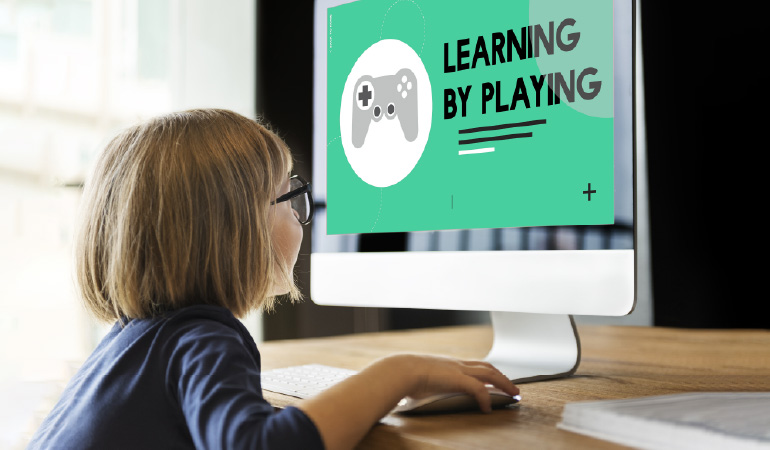
The concept of “gamification” is fairly new and fairly unknown before 2010–2011. Today, however, it’s a trending concept applying to a number of industries and activities, from school classes to the offices of large multinationals.
By definition, gamification is the process of embedding various game elements, like achievement levels, badges, point systems, quizzes, leaderboards, or other components and mechanics primarily related to games, into conventional learning activities (in-class or computer-based) with the primary purpose of boosting student engagement and motivation.
There is a distinction between gamification in education and game-based learning.
While gamification is a more general, overarching concept that can be applied even to traditional learning techniques, game-based learning is about designing and building eLearning gamification software — that is, wrapping entire courses into a simulator (a curriculum-based computer game).
What’s the point of gamification in education?
Gamification and game-based learning pursue the following goals:
Higher student engagement and motivation
In the traditional educational model with no gamification of learning, students are mostly involved in a one-to-one relationship with their teacher/professor. Once eLearning gamification is added, they find themselves in a friendly, yet challenging, many-to-many environment that naturally activates their competitive reflexes and motivates them to perform better and “beat the game” — that is, land as close to the top of the leaderboard as possible.
In addition, the gamification of the educational process can make the learning experience much more relatable for a lot of students. According to Statista, “In 2018, Americans aged between 15 to 19 years spent 49 minutes on gaming or leisurely computer use during an average weekday, and more than 90 minutes doing so during weekends or holidays.”
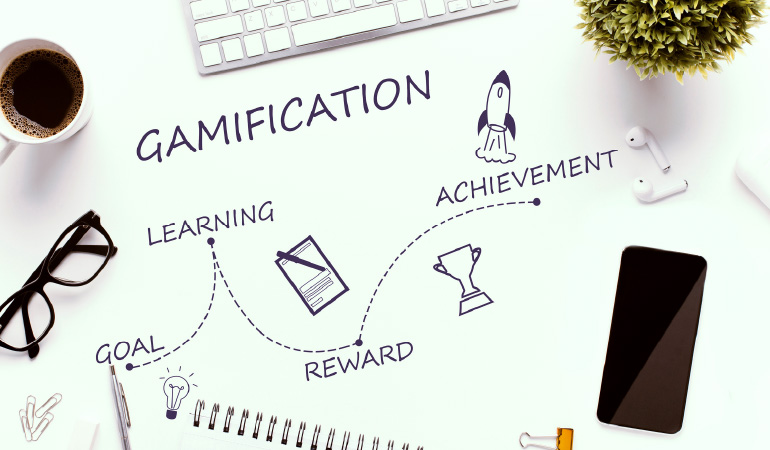
Better knowledge retention
According to the popular 70-20-10 model for learning and development, we only get 10% of our knowledge in any domain through actual training; 20% comes from observation and interaction with coworkers, while the remaining 70% is our own experience — the result of working on tasks, failing, trying again, and ultimately succeeding.
The diagram below demonstrates this model by showing the effectiveness of particular learning techniques/channels. The more hands-on and interactive the learning process becomes, the more students remember. Gamification uses this model to achieve the same — students are encouraged to take an active part in in-class activities, compete, and be proactive to claim their awards.
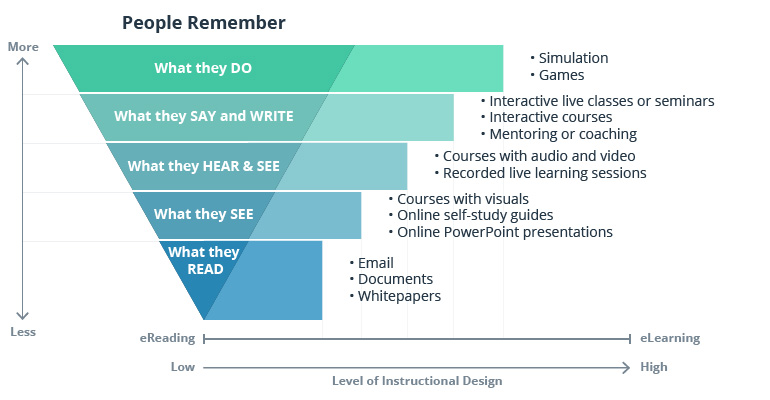
Source: eLearningIndustry
Combining theoretical knowledge with its practical application
One of the extra benefits of learning in a simulated environment or one with multiple gamification elements is the fixation of the action-result pattern in students’ minds. For example, instant feedback/evaluation or unlocking of new content upon the completion of certain tasks helps students learn incrementally and instantly take note of the things they got right, thus elevating their self-esteem and giving them a sense of accomplishment.
Technologies for eLearning gamification
From the technological perspective, pretty much every piece of the puzzle is already there. Existing LMS (Learning Management System) solutions can be customized or complemented with specialized eLearning gamification software that will augment existing courses with the necessary gamification elements.
As far as specific features are concerned, there is a lot to choose from. Below are just a few things that matter to most students, but the list can be easily expanded:
- Badges and achievements for reaching particular milestones
- Point and level-up systems for tracking student progress and contributions
- Levels/tiers with increasing difficulty for maintaining a competitive atmosphere
- Leaderboards for highlighting individual progress
- Progress bars for tracking individual progress throughout a course
- Instant feedback tools for on-the-spot assessment of student performance
Frequency of gamified elements reported in studies
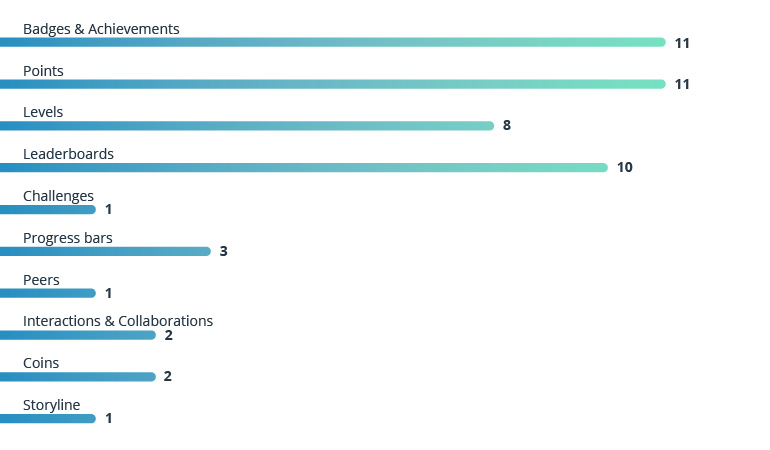
Source: ResearchGate
Gamification models and features can become quite complex. In language studies, for example, some eLearning solutions may feature AI-powered chatbots, deeply personalized and dynamically generated learning materials, or even natural language processing systems capable of replacing teachers in particular situations.
Gamification in education: Top principles
Although eLearning gamification projects can differ in terms of feature sets and technologies used, they will inevitably be based on the same general principles and techniques.
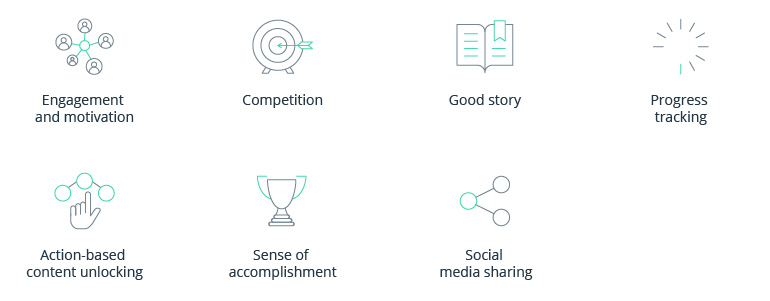
Engagement and motivation
Give your students a sense of belonging. Turn your learning course into a journey that they need to complete to become a new version of themselves.
Competition
There is no joy and no glory in being the winner in a one-person competition. Make sure each student is driven by a desire to claim the top prize.
Good story
Don’t give your students tests, make them quests. If an otherwise dull course is presented as a series of challenges wrapped into a compelling story, it will be a game changer.
Progress tracking
Your students deserve to know how they are doing. However, try reversing the scale and instead of using your regular score range, let them collect badges or points.
Action-based content unlocking
In games, it’s always super-exciting to see what’s behind that hill or massive wooden gate. Keep your students on the edge of their seat by allowing them to unlock new materials only after they’ve deserved it.
Sense of accomplishment
Knowing that you did a good job on a test is one thing, but seeing fireworks light up the sky on that occasion is a whole different story. Make sure your students know how proud you are of their success.
Social media sharing
Nobody likes celebrating alone; we all seek public recognition when we have great news to share. Enable your students to spread the word about the progress they’ve made in their studies for even more motivation.
Bottom line
The gamification of education may be a relatively recent fashion, but it’s here to stay. The students of today are tech-savvy, curious, and want to see innovation everywhere, including in their classes. As an independent educational institution or a company developing or integrating EdTech solutions, you are a conduit for progress. Start weaving gamification elements into your curriculum right now to gain the competitive edge.
Bringing positive changes to conservative, inert, and slowly evolving industries takes persistence, audacity, and the right set of technical skills. If you have what it takes to change the way people learn today and will learn in the future, but need help on the technical side, please feel free to contact us.



